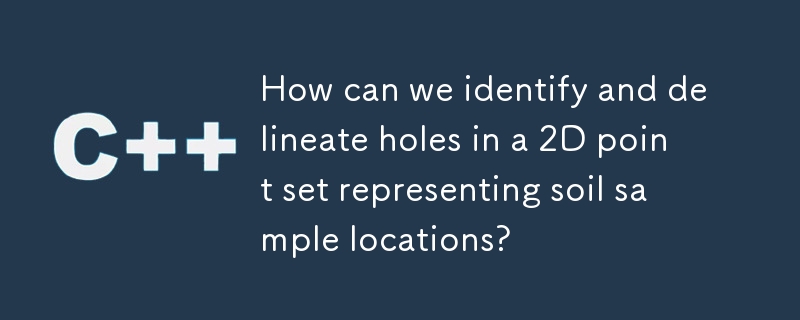我們如何辨識和描繪代表土壤樣本位置的二維點集中的孔?

在 2D 點集中查找孔
任務是在笛卡爾網格系統內的一組 2D 點中查找孔。這些點代表土壤樣本位置,洞穴可能包括巨大的岩石、沼澤或湖泊/池塘。目標是找到大致定義這些區域的凹多邊形,調整演算法的靈敏度來控制多邊形的粗糙度或平滑度。
解
步驟:
將孔段多邊形化:將線段轉換為凹多邊形。對點進行排序以確保正確的連接並刪除重複項。
using System;
using System.Collections.Generic;
public class Holes
{
// Density map (2D array)
private int[][] map;
// List of hole segments (lines)
private List<Line> segments;
// Polygonized holes (concave polygons)
private List<Polygon> holes;
// Polygonization tolerance (higher value = smoother polygons)
private double tolerance;
// Initializes the hole detection algorithm.
public Holes(int[][] points, int mapSize, double tolerance)
{
if (points == null || mapSize <= 0 || tolerance <= 0)
{
throw new ArgumentException("Invalid arguments");
}
// Initialize the variables
this.map = new int[mapSize][mapSize];
this.tolerance = tolerance;
this.segments = new List<Line>();
this.holes = new List<Polygon>();
// Create density map
CreateDensityMap(points, mapSize);
}
// Identifies holes in the density map.
public void FindHoles()
{
if (map == null || map.Length == 0)
{
throw new InvalidOperationException("Density map not initialized.");
}
// Find hole cells
List<Cell> holeCells = FindCells(0);
// Group hole cells into segments
List<List<Line>> lineGroups = GroupLines(holeCells);
// Polygonize segments
PolygonizeSegments(lineGroups);
}
// Helper functions for hole detection.
private void CreateDensityMap(int[][] points, int mapSize)
{
// Scale and project points onto a grid
for (int i = 0; i < points.Length; i++)
{
double scaledX = points[i][0] / points[0][0] * mapSize;
double scaledY = points[i][1] / points[0][1] * mapSize;
int x = (int)scaledX;
int y = (int)scaledY;
// Increment count in density map
map[x][y]++;
}
}
private List<Cell> FindCells(int threshold)
{
List<Cell> holeCells = new List<Cell>();
for (int i = 0; i < map.Length; i++)
{
for (int j = 0; j < map[i].Length; j++)
{
if (map[i][j] == 0 || map[i][j] <= threshold)
{
holeCells.Add(new Cell(i, j));
}
}
}
return holeCells;
}
private List<List<Line>> GroupLines(List<Cell> holeCells)
{
// Group lines by proximity
List<List<Line>> lineGroups = new List<List<Line>>();
foreach (Cell holeCell in holeCells)
{
List<Line> group = null;
// Find existing group or create a new one
for (int i = 0; i < lineGroups.Count; i++)
{
if (lineGroups[i].Find(line => line.Proximity(holeCell) <= tolerance) != null)
{
group = lineGroups[i];
break;
}
}
if (group == null)
{
group = new List<Line>();
lineGroups.Add(group);
}
// Add horizontal/vertical lines
group.Add(new Line(holeCell.x, holeCell.y, true));
group.Add(new Line(holeCell.x, holeCell.y, false));
}
return lineGroups;
}
private void PolygonizeSegments(List<List<Line>> lineGroups)
{
foreach (List<Line> lineGroup in lineGroups)
{
Polygon polygon = PolygonizeSegment(lineGroup);
if (polygon != null)
{
holes.Add(polygon);
}
}
}
private Polygon PolygonizeSegment(List<Line> lineSegment)
{
// Sort lines by angle (convex hull algorithm)
lineSegment.Sort((a, b) => a.Angle.CompareTo(b.Angle));
// Remove duplicate lines
List<Line> uniqueLines = new List<Line>();
foreach (Line line in lineSegment)
{
if (uniqueLines.Count == 0 || uniqueLines[uniqueLines.Count - 1].Angle != line.Angle)
{
uniqueLines.Add(line);
}
}
// Polygonize lines
List<Point> points = new List<Point>();
for (int i = 0; i < uniqueLines.Count; i++)
{
Point point = null;
Line currentLine = uniqueLines[i];
if (uniqueLines[(i + 1) % uniqueLines.Count].Angle - currentLine.Angle > Math.PI)
{
point = currentLine.GetIntersection(uniqueLines[(i + 1) % uniqueLines.Count], true);
}
else
{
point = currentLine.GetIntersection(uniqueLines[(i + 1) % uniqueLines.Count], false);
}
if (point != null)
{
points.Add(point);
}
}
return new Polygon(points);
}
// Helper classes for line/polygon representation.
private class Line
{
public int x1, y1, x2, y2;
public double angle;
public bool isHorizontal;
public Line(int x, int y, bool isHorizontal)
{
if (isHorizontal)
{
x1 = 0; y1 = y;
x2 = map.GetLength(0) - 1; y2 = y;
}
else
{
x1 = x; y1 = 0;
x2 = x; y2 = map[0].GetLength(0) - 1;
}
this.angle = Math.Atan2(y2 - y1, x2 - x1);
this.isHorizontal = isHorizontal;
}
public double Angle { get { return angle; } }
public double Proximity(Cell cell)
{
double distX, distY;
if (isHorizontal)
{
distX = cell.x - x1;
distY = cell.y - y1;
}
else
{
distX = cell.x - x2;
distY = cell.y - y2;
}
return Math.Sqrt(distX * distX + distY * distY);
}
public Point GetIntersection(Line other, bool isConvex)
{
double denominator, numerator, tx, ty;
if (isHorizontal)
{
denominator = (other.y2 - other.y1) - (y2 - y1);
numerator = ((other.x2 - other.x1) * (y1 - other.y1)) - ((x2 - x1) * (other.y2 - other.y1));
tx = numerator / denominator;
ty = other.y1 + ((tx - other.x1) * (other.y2 - other.y1)) / (other.x2 - other.x1);
}
else
{
denominator = (other.x2 - other.x1) - (x2 - x1);以上是我們如何辨識和描繪代表土壤樣本位置的二維點集中的孔?的詳細內容。更多資訊請關注PHP中文網其他相關文章!

熱AI工具

Undresser.AI Undress
人工智慧驅動的應用程序,用於創建逼真的裸體照片

AI Clothes Remover
用於從照片中去除衣服的線上人工智慧工具。

Undress AI Tool
免費脫衣圖片

Clothoff.io
AI脫衣器

Video Face Swap
使用我們完全免費的人工智慧換臉工具,輕鬆在任何影片中換臉!

熱門文章

熱工具

記事本++7.3.1
好用且免費的程式碼編輯器

SublimeText3漢化版
中文版,非常好用

禪工作室 13.0.1
強大的PHP整合開發環境

Dreamweaver CS6
視覺化網頁開發工具

SublimeText3 Mac版
神級程式碼編輯軟體(SublimeText3)
 C#與C:歷史,進化和未來前景
Apr 19, 2025 am 12:07 AM
C#與C:歷史,進化和未來前景
Apr 19, 2025 am 12:07 AM
C#和C 的歷史與演變各有特色,未來前景也不同。 1.C 由BjarneStroustrup在1983年發明,旨在將面向對象編程引入C語言,其演變歷程包括多次標準化,如C 11引入auto關鍵字和lambda表達式,C 20引入概念和協程,未來將專注於性能和系統級編程。 2.C#由微軟在2000年發布,結合C 和Java的優點,其演變注重簡潔性和生產力,如C#2.0引入泛型,C#5.0引入異步編程,未來將專注於開發者的生產力和雲計算。
 C和XML的未來:新興趨勢和技術
Apr 10, 2025 am 09:28 AM
C和XML的未來:新興趨勢和技術
Apr 10, 2025 am 09:28 AM
C 和XML的未來發展趨勢分別為:1)C 將通過C 20和C 23標準引入模塊、概念和協程等新特性,提升編程效率和安全性;2)XML將繼續在數據交換和配置文件中佔據重要地位,但會面臨JSON和YAML的挑戰,並朝著更簡潔和易解析的方向發展,如XMLSchema1.1和XPath3.1的改進。
 繼續使用C:耐力的原因
Apr 11, 2025 am 12:02 AM
繼續使用C:耐力的原因
Apr 11, 2025 am 12:02 AM
C 持續使用的理由包括其高性能、廣泛應用和不斷演進的特性。 1)高效性能:通過直接操作內存和硬件,C 在系統編程和高性能計算中表現出色。 2)廣泛應用:在遊戲開發、嵌入式系統等領域大放異彩。 3)不斷演進:自1983年發布以來,C 持續增加新特性,保持其競爭力。
 C#vs. C:學習曲線和開發人員的經驗
Apr 18, 2025 am 12:13 AM
C#vs. C:學習曲線和開發人員的經驗
Apr 18, 2025 am 12:13 AM
C#和C 的学习曲线和开发者体验有显著差异。1)C#的学习曲线较平缓,适合快速开发和企业级应用。2)C 的学习曲线较陡峭,适用于高性能和低级控制的场景。
 C和XML:探索關係和支持
Apr 21, 2025 am 12:02 AM
C和XML:探索關係和支持
Apr 21, 2025 am 12:02 AM
C 通過第三方庫(如TinyXML、Pugixml、Xerces-C )與XML交互。 1)使用庫解析XML文件,將其轉換為C 可處理的數據結構。 2)生成XML時,將C 數據結構轉換為XML格式。 3)在實際應用中,XML常用於配置文件和數據交換,提升開發效率。
 現代C設計模式:構建可擴展和可維護的軟件
Apr 09, 2025 am 12:06 AM
現代C設計模式:構建可擴展和可維護的軟件
Apr 09, 2025 am 12:06 AM
現代C 設計模式利用C 11及以後的新特性實現,幫助構建更靈活、高效的軟件。 1)使用lambda表達式和std::function簡化觀察者模式。 2)通過移動語義和完美轉發優化性能。 3)智能指針確保類型安全和資源管理。
 C社區:資源,支持和發展
Apr 13, 2025 am 12:01 AM
C社區:資源,支持和發展
Apr 13, 2025 am 12:01 AM
C 學習者和開發者可以從StackOverflow、Reddit的r/cpp社區、Coursera和edX的課程、GitHub上的開源項目、專業諮詢服務以及CppCon等會議中獲得資源和支持。 1.StackOverflow提供技術問題的解答;2.Reddit的r/cpp社區分享最新資訊;3.Coursera和edX提供正式的C 課程;4.GitHub上的開源項目如LLVM和Boost提陞技能;5.專業諮詢服務如JetBrains和Perforce提供技術支持;6.CppCon等會議有助於職業
 超越炒作:評估當今C的相關性
Apr 14, 2025 am 12:01 AM
超越炒作:評估當今C的相關性
Apr 14, 2025 am 12:01 AM
C 在現代編程中仍然具有重要相關性。 1)高性能和硬件直接操作能力使其在遊戲開發、嵌入式系統和高性能計算等領域佔據首選地位。 2)豐富的編程範式和現代特性如智能指針和模板編程增強了其靈活性和效率,儘管學習曲線陡峭,但其強大功能使其在今天的編程生態中依然重要。






